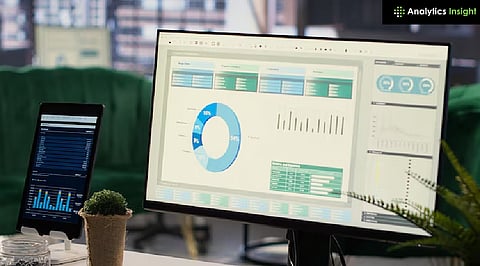
Key Takeaways
Digital twins use live data streams for real-time monitoring and simulation.
AI integration enhances predictive analytics and system automation.
Data governance ensures accuracy, security, and operational trust.
Enterprises aren’t short on data. They’re drowning in it. IoT sensors, connected devices, and cloud-native apps are generating live data around the clock. While the volume grows, traditional IT systems, built for static dashboards and delayed reporting, are reaching their limits.
This results in bottlenecks in analysis, slow reactions, and blind spots in operations. The requirement today is no longer to simply process data, but to sense and respond to data, while changes happen.
What’s Digital Twins Doing About It?
Digital twins are transforming fixed engineering tools into active operational engines. Fundamentally, digital twins are real-time software copies of physical systems. They consume telemetry from sensors, simulate behaviors, and produce insights from current states, not past averages.
Being run in-memory on server clusters, they eliminate latency dramatically. They don’t monitor data, respond to data, model outcomes, or suggest improvements.
They are perfect for sophisticated environments:
Cities with intelligent traffic management, energy efficiency, and security.
Air travel companies are modeling how one delay cascades through international schedules.
Enterprises monitor data center loads or logistics streams in real-time.
The trend is obvious: digital twins are becoming the central logic layer for real-time decision-making.
Also Read: 10 Best SEO Tricks to Improve Your Google Rankings in 2025
How Do Digital Twins Get an AI Boost?
As digital twins get an AI boost, they unlock predictive and prescriptive insights.
AI models are able to identify patterns and outliers that human operators or rule-based systems may not catch. In cybersecurity, a digital twin could simulate ordinary traffic, while AI identifies common wisps of anomalies pointing to intrusions, before any breach.
In IT operations, AI-powered twins can predict demand, optimize server use, or initiate scaling actions based on pattern identification, not merely thresholds.
AI makes digital twins more than mere observers; they become active guides. They no longer simply report on what is going on. They forecast what will occur and why it’s important.
What About AI Hallucinations? Can Twins Cure That?
AI hallucinations are when generative models generate plausible-sounding but untrue outcomes. This tends to take place when models do not have access to real-time, validated data.
Digital twins remedy that by keeping AI anchored to the world. With retrieval-augmented generation (RAG), they continuously provide AI systems with live, context-rich information. That keeps answers up to date and traceable.
Example: An AI model in a supply chain may recommend diverting inventory. Without current stock or delivery information, it may be incorrect. When a digital twin provides it with live updates, the same model is exact, responsive, and actionable.
This is where digital twins begin to serve a dual purpose: real-time managers of systems and AI engines of truth.
Is AI Transforming How Digital Twins Are Developed?
Building digital twins previously meant tedious dev sprints, manual coding of telemetry streams, system state, APIs, and analytics logic. Today, AI tools can automate most of that.
For instance:
Ingesting ingestion code for multi-cloud telemetry? Auto-generated.
Setting monitoring thresholds on 1000+ endpoints? Suggested and verified by AI.
Testing edge-case scenarios? AI can simulate and score it.
This allows human engineers to concentrate on architecture and integration, while leaving AI to speed up deployment and iteration.
So, What’s the Big Picture Here?
AI and digital twins are creating a new type of stack: one that thinks, anticipates, and reacts in real-time.
Together, they’re not just making data management better, they’re redefining it. From factories and flight routes to cloud systems and smart cities, they’re making enterprises stay alert, robust, and responsive.
The competitive advantage isn’t about having more data anymore; it’s about having the appropriate systems in place to interpret and respond to that data quicker than anyone else.
Final Thoughts: From Insight to Advantage
Companies that are based on legacy analytics are playing catch-up. Companies that deploy digital twins with AI capabilities are creating smart control towers for their businesses.
This convergence, predictive intelligence-powered real-time models, is more than a technological improvement. This is a fundamental change. Digital twins revolutionize the way organizations plan, react, and govern.
In an age where data does not rest, digital twins + AI provide better than dashboards: a real-time grasp of whatever is important.
Also Read: Top 10 Google SEO Certification Courses to Boost Your Skills
FAQs
1. What exactly is a digital twin?
A digital twin is a real-time, virtual model of a physical system or process that ingests live data to simulate, monitor, and optimize performance.
2. How does AI improve digital twins?
AI adds predictive capabilities to digital twins, spotting patterns, detecting anomalies, and recommending actions based on real-time data.
3. Can digital twins prevent AI hallucinations?
Yes. Digital twins supply current, verified data to AI models, reducing the risk of inaccurate or fabricated outputs.
4. Where are digital twins most commonly used?
They’re used in smart cities, manufacturing, logistics, cloud infrastructure, and cybersecurity to monitor and optimize live operations.
5. Is AI helping to build digital twins faster?
Absolutely. AI tools can auto-generate code, streamline API integrations, and validate models, reducing development time significantly.
#ResearchDataExcellence #DataAnalysisAwards #InternationalDataAwards #ResearchDataAwards #DataExcellence #ResearchData #DataAnalysis #DataAwards #GlobalDataExcellence #DataInnovationAwards #DataResearch #ExcellenceInData #DataAwardWinners#DataAnalysisExcellence #ResearchDataInsights #GlobalResearchAwards #DataExcellenceAwards #ExcellenceInResearchData #ResearchDataLeadership #DataResearchExcellence #AwardWinningData #InternationalResearchAwards #DataAnalysisInnovation #ResearchDataAchievement #ExcellenceInDataAnalysis #GlobalDataInsights #ResearchDataSuccess #DataAwards2024
Website: International Research Data Analysis Excellence Awards
Visit Our Website : researchdataanalysis.com
Nomination Link : researchdataanalysis.com/award-nomination
Registration Link : researchdataanalysis.com/award-registration
member link : researchdataanalysis.com/conference-abstract-submission
Awards-Winners : researchdataanalysis.com/awards-winners
Contact us : rdat@researchdataanalysis.com
Get Connected Here:
==================
Facebook : www.facebook.com/profile.php?id=61550609841317
Twitter : twitter.com/Dataanalys57236
Pinterest : in.pinterest.com/dataanalysisconference
Blog : dataanalysisconference.blogspot.com
Instagram : www.instagram.com/eleen_marissa
Comments
Post a Comment